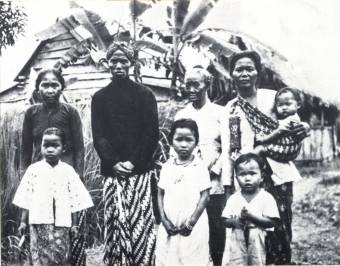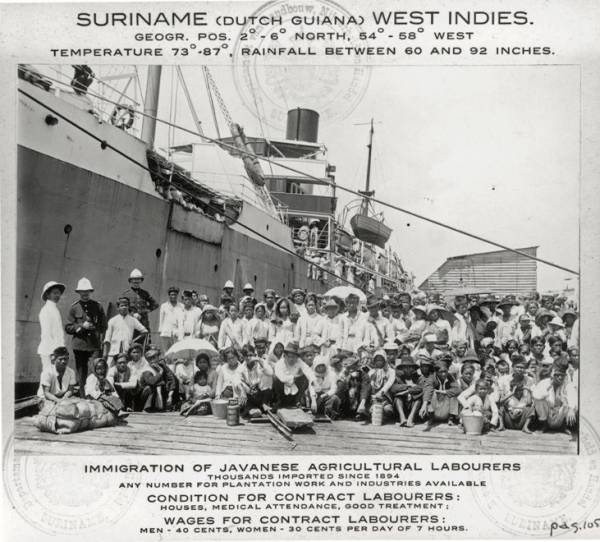A history of colonial labour and migration has produced a unique community far from Indonesian shores
Rosemarijn Hoefte
Javanese immigrants arriving in ParamariboKITLV Special Collections |
Perhaps few people in Indonesia know that there is a large community of people of Indonesian descent living in the north of the continent of South America. Over 70,000 ‘Javanese’ live in Suriname, a former Dutch colony and vibrant multicultural country located north of Brazil on the Caribbean coast. Although they have been there for several generations, many of them still identify as Javanese, even though very few have ever visited the island of Java or maintain family connections there. But they speak a creolised version of the Javanese language, Javanese names crop up at all levels of society and elements of Javanese culture (such as cuisine) have influenced this Caribbean nation’s culture.
A colonial history
Why are tens of thousands of people of Javanese descent living in Suriname? It all has to do with the abolition of slavery and the importance of the plantation system in this colony. In 1863, the Dutch government freed more than 33,000 slaves in Suriname. In the aftermath of this abolition, the authorities followed other Caribbean colonies by importing indentured workers from British India to supply the plantations with cheap and submissive labour. The five-year contracts detailed the rights and the duties of the indentureds. Crucial to the contract labour system was the so-called penal sanction, which gave the employer the right to press criminal charges against indentureds who broke their labour contract.
Between 1873 and 1916 more than 34,000 British Indians came to Suriname. Soon, however, doubts arose on the source of this contract labour. The main problem was that the British Indian immigrants remained foreign nationals, and therefore a considerable proportion of the population of Suriname would soon be British. Moreover, these subjects could appeal against the decisions of the highest Dutch authority and request assistance of the British consul, which would not enhance the submissiveness of the labour force. Additional worries were the reliance on a foreign country for labour and the growing nationalist movement in India, which fiercely attacked the system of contract migration. Indeed, in India the system was abolished in 1916.
Turning to Java
Java was considered as an alternative source of labour. Initial attempts to import people from Java came to naught because the Dutch government did not permit the migration of Javanese when there existed the possibility of acquiring labour in India. Yet the movement to recruit Javanese gained strength in the 1880s due to the changing political climate in India. Another advantage was that the Dutch themselves would be in control of the recruitment and immigration process and would not have to compete with other recruiting nations, as was the case in India.
Javanese cultural traditions have proven to be strong, even though changes and adaptations in Suriname, for example in language, were inevitable
The Dutch colonial minister objected to emigration from Java as late as 1887 by arguing that the populace of Java was not inclined to migrate to far-away and unknown Suriname. After heavy lobbying from Surinamese planters and officials, the government finally decided to allow a first experiment with one hundred Javanese contract migrants in 1890. Despite doubts about the physical strength of the new labourers, Javanese migration to Suriname was now authorised. In total, almost 33,000 Javanese migrated to Suriname in the period 1890-1939. Central Java and the regions near Batavia (Jakarta), Surabaya and Semarang were the main recruitment areas. Only 20 to 25 percent of the Javanese migrants returned to their home country before World War II. The great majority of the immigrants settled permanently in Suriname.
The migrants were assigned to plantations. According to the contract, the plantation had to provide free housing for its indentured labourers. However, the quality of the housing was often substandard. The Dutch East Indian official H. van Vleuten, who visited Suriname in 1909 to investigate the living and working conditions of the Javanese, reported that the domestic life of the Javanese immigrants appeared to him as ‘rather sad’. Most of the rooms ‘gave the impression of great poverty of their inhabitants.’ The labour contract fixed the wages of men and women, yet most indentureds pointed out that they did not earn the listed wages. Van Vleuten concluded that ‘the average wage earned by contract labourers is far below the minimum.’ He argued that the earnings were much too low to make a living in a colony as expensive as Suriname.
Besides these material problems, the Javanese also had to cope with adjustment to a new life, diet, and work regime in an often hostile environment. Not surprisingly, homesickness plagued many of the migrants. The desire to return to Java served as a form of escapism. This escapism and other techniques, such as feigned illnesses, served as hidden forms of protest against the indenture system.
Cultural continuity
 |
A family of Javanese peasants at Meerzorg plantationKITLV Special Collections |
Javanese cultural traditions have proven to be strong, even though changes and adaptations in Suriname, for example in language, were inevitable. Yet second and later generations still identify with their country of origin. The Surinamese government also actively promoted the survival of Javanese culture in the period before World War II. In the 1930s, the governor initiated an ‘Indianisation’ project to populate the colony with Javanese smallholders, who would settle in Javanese-style villages (desa) complete with their own religious and civil leadership. This program was cut short by the war.
After the war, the changed political landscape allowed for the formation of political parties in Suriname. The two Javanese parties were, like all other parties, based on ethnicity rather than ideology. There existed a strong rivalry between their leaders, Iding Soemita and Salikin Hardjo. The latter was not very successful in the first general elections in 1949 and then concentrated on encouraging a return to Java by a select group of skilled people. In 1954, one thousand Javanese sailed for Indonesia, to start an agricultural co-operative in Tongar in West Sumatra. A second exodus took place in the 1970s, when some 20,000 Javanese left for the Netherlands on the eve of Suriname’s independence in 1975.
Politically, the importance of the Javanese population group is indisputable
Politically, the importance of the Javanese population group is indisputable. The Javanese often hold the balance between the larger and more powerful Afro-Surinamese and Hindustani (former British Indians) groups. At present, Paul Slamet Somohardjo is the first-ever Javanese Speaker of the National Assembly. Their socioeconomic development was slower, but since the 1960s the Javanese have been catching up with other population groups, even though the urbanisation rate is still lower than that of other large groups. Following the demise of the plantations in the first half of the twentieth century, many Javanese found work in the bauxite industry and the agricultural sector. Only in the last decades of the last century did the Javanese presence in businesses, the professions and the civil service increase.
Demographically, the Javanese have long been the third largest population group, but the Maroons (descendants of runaway slaves) narrowly surpassed them in the most recent census of 2004. According to these figures, the Hindustani group counts 135,000 people, followed by the Afro-Surinamese (87,500), Maroons (72,600), and Javanese (71,900). The Javanese have added a unique ethnic and cultural element to the Caribbean and Latin America. Yet, this has not generated much research interest in the Javanese and their culture. Therefore it would be good to gain more knowledge about the lives, culture, and progress of the Javanese in Suriname. It is certainly worth it! ii
Rosemarijn Hoefte (hofte@kitlv.nl ) is head of the Department of Collections and coordinator of the Caribbean Expert Center at the KITLV Institute, Leiden, The Netherlands.











